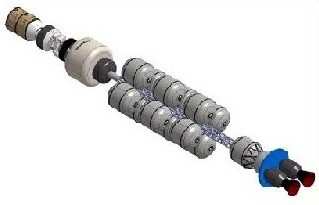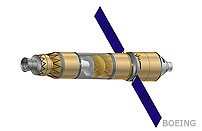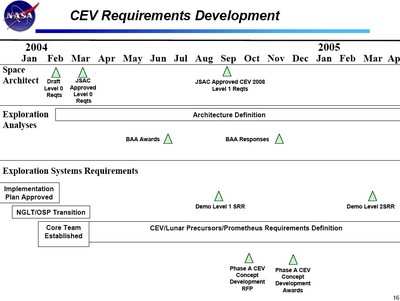This Could Be The First Step Back To The Moon
Northrop Grumman and Boeing Chave completed and signed a formal
agreement to compete as a team for NASA's new Crew Exploration
Vehicle (CEV) and related human lunar exploration systems.

The agreement was signed Friday, comes just one week after the
one-year anniversary of the nation's decision to renew its
commitment to space exploration. It concludes a negotiation process
that began in October when the companies signed a memorandum of
agreement to explore teaming opportunities.The major participants
in the agreement are Northrop Grumman's Integrated Systems sector
and Boeing NASA Systems.
Under the agreement, Northrop Grumman will serve as the team's
leader and prime contractor during the initial development phase of
the CEV, known as Spiral 1. During this period, which will
demonstrate the CEV's ability to operate safely with astronauts in
low-Earth orbit, Boeing will serve as Northrop Grumman's teammate
and principal subcontractor.During Spiral 2, which will begin the
expansion of human space exploration to the moon and beyond, Boeing
will serve as prime contractor for the lunar mission elements. For
this work, Northrop Grumman will serve as Boeing's teammate and
principal subcontractor.
 A formal request for proposals to
begin development of the CEV system is expected from NASA in
March.The space agency is expected to award two CEV system
development and demonstration contracts by late summer.
A formal request for proposals to
begin development of the CEV system is expected from NASA in
March.The space agency is expected to award two CEV system
development and demonstration contracts by late summer.
"This agreement officially launches a team that has the
space-systems integration expertise, technology innovation and
human space-flight experience to design, develop and produce a
safe, highly innovative and affordable crew exploration vehicle,"
said Gary W. Ervin, sector vice president for Northrop Grumman
Integrated Systems. "We embrace the technical and logistic
challenges of space exploration that await us as we partner with
NASA to define and produce the bridge that will carry the nation
back to the Moon and beyond."
CEV will serve as the central human space-transportation system
within NASA's Project Constellation, a broader architecture of
human and robotic space systems that will be required to ferry
astronauts to the Moon and beyond. CEV will carry astronauts to and
from low-Earth orbit, and will include power, propulsion and
life-support systems. It will also include a launch-abort system to
protect the crew and separate it from the launch vehicle in the
event of a problem on the launch pad or during the ascent phase of
launch.

For a lunar mission, the CEV will be integrated with additional
systems that will propel it beyond low-Earth orbit to a staging
point near the Moon.The lunar mission will also require a secondary
space system that will allow the crew to travel from the staging
area to the Moon's surface, sustain the crew on the Moon, and
transport it safely back to the in-space staging point.
"The past 12 months have witnessed a tremendous rebirth of the
nation's hunger for and curiosity about human space travel and the
exploration of distant worlds," said Chuck Allen, Boeing's vice
president for space exploration systems. "Boeing and Northrop
Grumman have come together in a spirit of collaborative partnership
to use our technological and engineering expertise, unmatched human
space flight experience and a singular focus on mission success to
help NASA and the nation fulfill its space exploration goals."
 Unfortunate... ANN/SportPlane Resource Guide Adds To Cautionary Advisories
Unfortunate... ANN/SportPlane Resource Guide Adds To Cautionary Advisories ANN FAQ: Turn On Post Notifications
ANN FAQ: Turn On Post Notifications ANN's Daily Aero-Term (04.29.24): Visual Approach Slope Indicator (VASI)
ANN's Daily Aero-Term (04.29.24): Visual Approach Slope Indicator (VASI) ANN's Daily Aero-Term (04.28.24): Airport Marking Aids
ANN's Daily Aero-Term (04.28.24): Airport Marking Aids ANN's Daily Aero-Linx (04.28.24)
ANN's Daily Aero-Linx (04.28.24)





